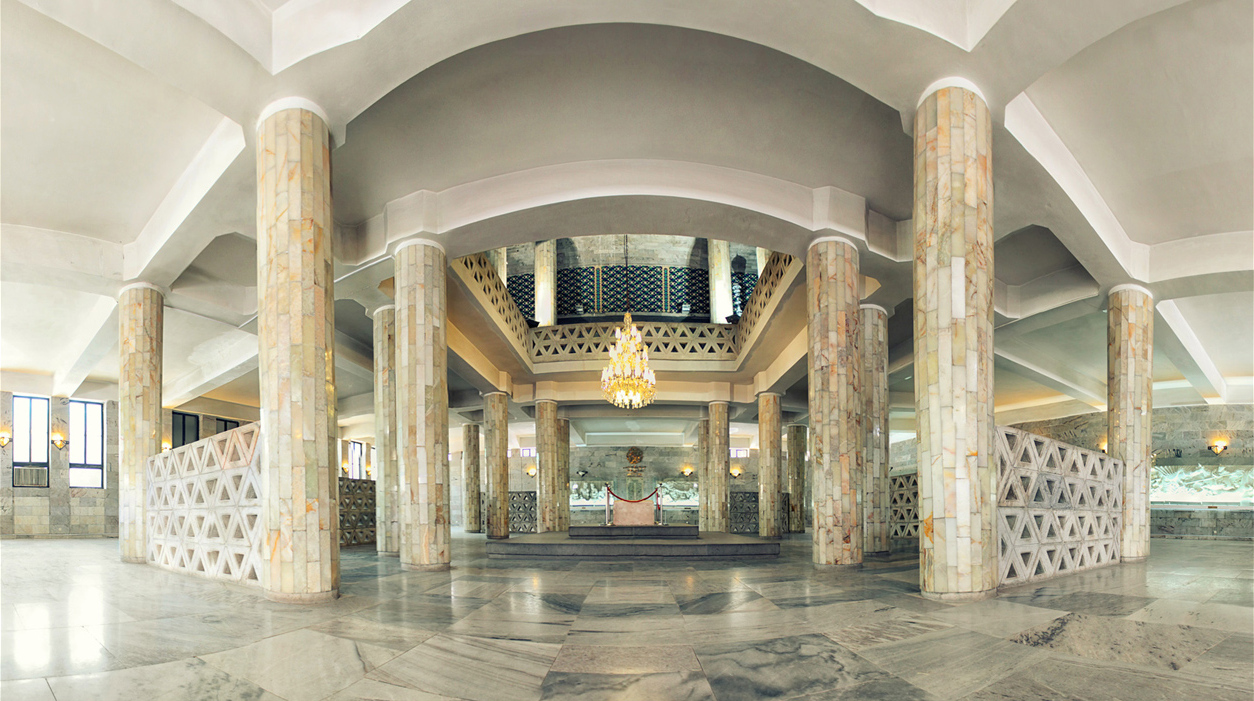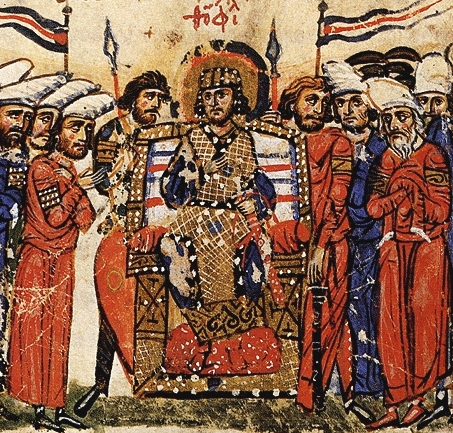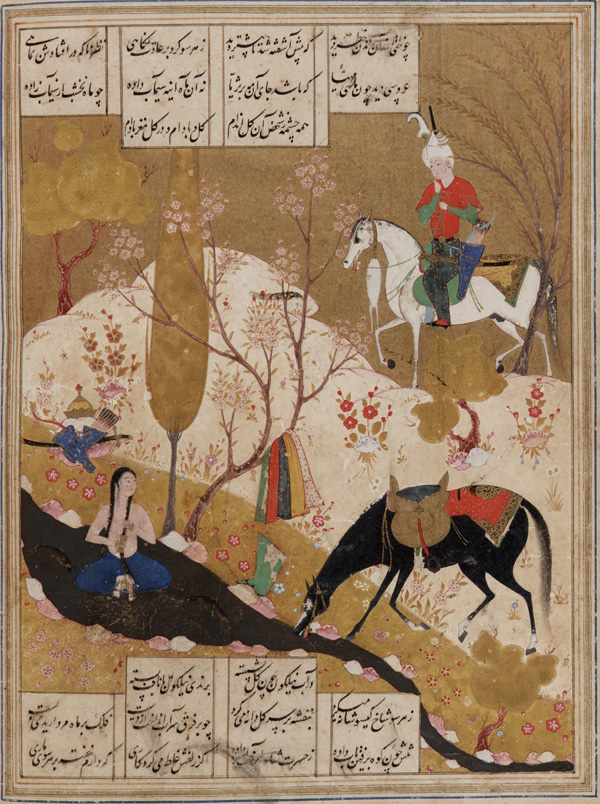|
Eskandar-nāme
The ''Iskandarnameh'' (''Book of Alexander''),' is the oldest Persian recension of the '' Alexander Romance'' tradition, anonymous and dated to some time between the eleventh and fourteenth centuries, although recently its compilation has been placed in the eleventh century by Evangelos Venetis, during the reign of Mahmud of Ghazni in the court of the Ghaznavid Empire. Alexander is described as a Muslim king and prophet and is identified with the conqueror named Dhu al-Qarnayn in the Quran. This identification is also witnessed in the Arabic recensions of the Alexander romance, such as the Qissat al-Iskandar and the Qissat Dhulqarnayn. As such, he is double-horned and builds the famous Gates of Alexander against Gog and Magog. The composition of the ''Iskandarnameh'' was influenced by earlier Persian compositions, such as the ''Shahnameh'' of Ferdowsi. Manuscripts The ''Iskandarnameh'' is known through one manuscript, located in the private collection of Sa‘īd Nafīsī in Teh ... [...More Info...] [...Related Items...] OR: [Wikipedia] [Google] [Baidu] |
Iskandarnameh Of Nizami
The ''Iskandarnameh'' (''Book of Alexander'') is a poetic production in the ''Alexander Romance'' tradition authored by the Persian poet Nizami Ganjavi (d. 1209) that describes Alexander the Great as an idealized hero, sage, and king. More uniquely, he is also a seeker of knowledge who debates with great Greek and Indian philosophers, one of them being Plato. The poem is the fourth part of the Khamsa of Nizami, a posthumous collection of five of Nizami's major works. It consists of two main and independent parts: the ''Sharaf-nama'' (Book of Glory) followed by the Iqbal-nama (Book of Fortune) (though the names are reversed in some copies). Both are written in rhymed couplets. In India, the two sections are known as the ''Eskandar-(''or ''Sekandar-) nāma-ye barrī'' and ''baḥrī'' respectively. It was likely completed by 1194. Narrative Summary The Sharaf-nama discusses the birth of Alexander, his succession to the throne of Rum (Greece), his wars against Africans who inv ... [...More Info...] [...Related Items...] OR: [Wikipedia] [Google] [Baidu] |
Qissat Dhulqarnayn
The Qiṣṣat Dhī ʾl-Qarnayn (''Qissat Dhulqarnayn'', "Story of Dhulqarnayn") is a Hispano-Arabic legend of Alexander the Great preserved in two fourteenth-century manuscripts in Madrid and likely dates as a ninth-century Arabic translation of the Syriac Alexander Romance produced in Al-Andalus. In this respect, it is similar to the '' Hadīth Dhī ʾl-Qarnayn'' and is an example of the literary genre of Qisas al-Anbiya (Stories of the Prophets). It is to be distinguished from another text also known as the ''Qissat Dhulqarnayn'' found in the book of prophets by al-Tha'labi (d. 1036) as well as the '' Qiṣṣat al-Iskandar'', a text dating to the late eighth or early ninth century representing the earliest translation of the Alexander Romance into Arabic. The Qissat depicts the travels of Alexander whom it identifies with the figure named Dhu al-Qarnayn ("The Two Horned One") in Surah al-Kahf of the Quran, referred to as Dhulqarnayn in the text (in Arabic-language Alexander ... [...More Info...] [...Related Items...] OR: [Wikipedia] [Google] [Baidu] |
11th-century Literature
The 11th century is the period from 1001 (represented by the Roman numerals MI) through 1100 (MC) in accordance with the Julian calendar, and the 1st century of the 2nd millennium. In the history of Europe, this period is considered the early part of the High Middle Ages. There was, after a brief ascendancy, a sudden decline of Byzantine power and a rise of Norman domination over much of Europe, along with the prominent role in Europe of notably influential popes. Christendom experienced a formal schism in this century which had been developing over previous centuries between the Latin West and Byzantine East, causing a split in its two largest denominations to this day: Roman Catholicism and Eastern Orthodoxy. In Song dynasty China and the classical Islamic world, this century marked the high point for both classical Chinese civilization, science and technology, and classical Islamic science, philosophy, technology and literature. Rival political factions at the Song dynasty ... [...More Info...] [...Related Items...] OR: [Wikipedia] [Google] [Baidu] |
Tehran
Tehran (; , ''Tehrân'') is the capital and largest city of Iran. It is the capital of Tehran province, and the administrative center for Tehran County and its Central District (Tehran County), Central District. With a population of around 9.8 million in the city as of 2025, and 16.8 million in the metropolitan area, Tehran is the List of largest cities of Iran, most populous city in Iran and Western Asia, the Largest metropolitan areas of the Middle East, second-largest metropolitan area in the Middle East after Cairo, and the 24th most populous metropolitan area in the world. Greater Tehran includes several municipalities, including, Karaj, Eslamshahr, Shahriar, Tehran province, Shahriar, Qods, Iran, Qods, Malard, Golestan, Tehran, Golestan, Pakdasht, Qarchak, Nasimshahr, Parand, Pardis, Andisheh and Fardis. In the classical antiquity, part of the territory of present-day Tehran was occupied by Rhages (now Ray, Iran, Ray), a prominent Medes, Median city almost entirely des ... [...More Info...] [...Related Items...] OR: [Wikipedia] [Google] [Baidu] |
Ferdowsi
Abu'l-Qâsem Ferdowsi Tusi (also Firdawsi, ; 940 – 1019/1025) was a Persians, Persian poet and the author of ''Shahnameh'' ("Book of Kings"), which is one of the world's longest epic poetry, epic poems created by a single poet, and the greatest epic of Persian-speaking people, Persian-speaking countries. Ferdowsi is celebrated as one of the most influential figures of Persian literature and one of the greatest in the history of literature. Name Except for his ''kunya (Arabic), kunya'' ( – , meaning 'father of Qasem') and his Takhallus, pen name ( – ''Ferdowsī'', meaning 'Paradise, paradisic'), nothing is known with any certainty about his full name. According to Djalal Khaleghi-Motlagh, the information given by the 13th-century author Bundari about Ferdowsi's name should be taken as the most reliable. Bundari calls the poet al-Amir al-Hakim Abu'l-Qasem Mansur ibn al-Hasan al-Ferdowsi al-Tusi. From an early period on, he has been referred to by different additional na ... [...More Info...] [...Related Items...] OR: [Wikipedia] [Google] [Baidu] |
Shahnameh
The ''Shahnameh'' (, ), also transliterated ''Shahnama'', is a long epic poem written by the Persian literature, Persian poet Ferdowsi between and 1010 CE and is the national epic of Greater Iran. Consisting of some 50,000 distichs or couplets (two-line verses), the ''Shahnameh'' is one of the world's longest epic poems, and the longest epic poem created by a single author. It tells mainly the Persian mythology, mythical and to some extent the historical past of the Persian Empire from the creation of the world until the Muslim conquest of Persia, Muslim conquest in the seventh century. Iran, Azerbaijan, Afghanistan, Tajikistan and the greater Greater Iran, region influenced by Persian culture such as Armenia, Dagestan, Georgia (country), Georgia, Turkey, Turkmenistan and Uzbekistan celebrate this national epic. The work is of central importance in Persian culture and Persian language. It is regarded as a literary masterpiece, and definitive of the ethno-national cultural ide ... [...More Info...] [...Related Items...] OR: [Wikipedia] [Google] [Baidu] |
Gog And Magog
Gog and Magog (; ) or Ya'juj and Ma'juj () are a pair of names that appear in the Bible and the Quran, Qur'an, variously ascribed to individuals, tribes, or lands. In Ezekiel 38, Gog is an individual and Magog is his land. By the time of the New Testament's Revelation 20 (), Jewish tradition had come to view Ezekiel's "Gog ''from'' Magog" as "Gog ''and'' Magog". The Gog prophecy is meant to be fulfilled at the approach of what is called the "Eschatology, end of days", but not necessarily the end of the world. Jewish eschatology viewed Gog and Magog as enemies to be defeated by the Messiah in Judaism, Messiah, which would usher in the age of the Messiah. One view within Christianity is more starkly Apocalypse, apocalyptic, making Gog and Magog allies of Satan against God at the end of the Millennialism, millennium, as described in the Book of Revelation. A legend was attached to Gog and Magog by the time of the Pax Romana, Roman period, that the Gates of Alexander were erected by ... [...More Info...] [...Related Items...] OR: [Wikipedia] [Google] [Baidu] |
Gates Of Alexander
The Gates of Alexander, also known as the Caspian Gates, are one of several mountain passes in eastern Anatolia, the Caucasus, and Persia, often imagined as an actual fortification, or as a symbolic boundary separating the civilized from the uncivilized world. The original Gates of Alexander were just south of the Caspian Sea, at Rhagae, where Alexander crossed while pursuing Darius III. The name was transferred to passes through the Caucasus, on the other side of the Caspian, by the more fanciful historians of Alexander. Various other passes in the Caucasus and Anatolia have been called the Gates of Alexander since at least the 1st century CE. Later, the Caspian Gates were also identified with the Pass of Derbent (in modern Dagestan) on the Caspian; or with the Pass of Dariel, a gorge forming a pass between Georgia and North Ossetia–Alania. Tradition also connects it to the Great Wall of Gorgan (Red Snake) on its south-eastern shore. These fortifications were historically ... [...More Info...] [...Related Items...] OR: [Wikipedia] [Google] [Baidu] |
Qissat Al-Iskandar
The ''Qiṣṣat al-Iskandar'' (fully the ''Qiṣṣat al-Iskandar wa-mā fīhā min al-amr al-ʿadjīb'', or "The story of Alexander and the wonderful things it contains") is the earliest narrative of Alexander the Great in the tradition of the '' Alexander Romance'' genre in the Arabic language. It was composed by ‘Umara ibn Zayd (also spelled Omâre Ebn-Zeyd) (767-815) between the late 8th to the early 9th century as a recension on the Syriac Alexander Legend. It is not to be confused with the ''Qissat Dhulqarnayn'' or the '' Sirat al-Iskandar''. The text offers a chain of transmission going back to the earliest days of Islam, claiming to rely on transmitters including Ka'b al-Ahbar, Ibn Abbas, Hasan al-Basri, Ibn Ishaq and others. Synopsis In the Qissat al-Iskandar, Alexander the Great is depicted as a civilizing hero and monotheist that travels across the world, builds the Wall against Gog and Magog, searches for the Water of Life (Fountain of Youth), and encounters a ... [...More Info...] [...Related Items...] OR: [Wikipedia] [Google] [Baidu] |
Nizami Ganjavi
Nizami Ganjavi (; c. 1141 – 1209), Nizami Ganje'i, Nizami, or Nezāmi, whose formal name was Jamal ad-Dīn Abū Muḥammad Ilyās ibn-Yūsuf ibn-Zakkī,Mo'in, Muhammad(2006), "Tahlil-i Haft Paykar-i Nezami", Tehran.: p. 2: Some commentators have mentioned his name as “Ilyas the son of Yusuf the son of Zakki the son of Mua’yyad” while others have mentioned that Mu’ayyad is a title for Zakki. Mohammad Moin, rejects the first interpretation claiming that if it were to mean 'Zakki son of Muayyad' it should have been read as 'Zakki i Muayyad' where izafe (-i-) shows the son-parent relationship but here it is 'Zakki Muayyad' and Zakki ends in silence/stop and there is no izafe (-i-). Some may argue that izafe is dropped due to meter constraints but dropping parenthood izafe is very strange and rare. So it is possible that Muayyad was a sobriquet for Zaki or part of his name (like Muayyad al-Din Zaki). This is supported by the fact that later biographers also state Yusuf was ... [...More Info...] [...Related Items...] OR: [Wikipedia] [Google] [Baidu] |
Quran
The Quran, also Romanization, romanized Qur'an or Koran, is the central religious text of Islam, believed by Muslims to be a Waḥy, revelation directly from God in Islam, God (''Allah, Allāh''). It is organized in 114 chapters (, ) which consist of individual verses ('). Besides its religious significance, it is widely regarded as the finest work in Arabic literature, and has significantly influenced the Arabic, Arabic language. It is the object of a modern field of academic research known as Quranic studies. Muslims believe the Quran was orally revealed by God to the final Islamic Prophets and messengers in Islam, prophet Muhammad in Islam, Muhammad through the Angel#Islam, angel Gabriel#Islam, Gabriel incrementally over a period of some 23 years, beginning on the Night of Power, Laylat al-Qadr, when Muhammad was 40, and concluding in 632, the year of his death. Muslims regard the Quran as Muhammad's most important Islamic view of miracles, miracle, a proof of his prophet ... [...More Info...] [...Related Items...] OR: [Wikipedia] [Google] [Baidu] |








